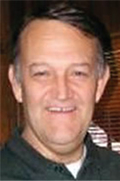Tuning Classes
NOTE: Click on an instructor's name to see a bio.
Aural Pitch Adjusting Techniques
Dan Levitan, RPT
Dan Levitan, RPT
 Daniel Levitan, the author of The Craft of Piano Tuning and the former tuning editor of The
Piano Technicians Journal, is best known for his groundbreaking research into inharmonicity, his insightful approach to the mechanics of tuning, and his innovative tuning hammer designs. A graduate of the North Bennet Street School (1975), he works as a field piano service technician in New York City.
Daniel Levitan, the author of The Craft of Piano Tuning and the former tuning editor of The
Piano Technicians Journal, is best known for his groundbreaking research into inharmonicity, his insightful approach to the mechanics of tuning, and his innovative tuning hammer designs. A graduate of the North Bennet Street School (1975), he works as a field piano service technician in New York City.
This class features a complete aural pitch raise of a grand piano, using a variety of extremely fast and accurate techniques that offer a pleasant break from the ETD.
Ergonomic Tuning: Tools and Techniques (Reyburn Piano Tech)
Nate Reyburn, RPT
[an error occurred while processing this directive]
Using the right tools the right way is crucial for beginners and veterans. This hands-on class introduces ways to reduce tuning stress on your body using both impact hammers and the traditional rigid lever. We'll cover the basics as well as some advanced tips, and then offer hands-on instruction.
Six Things You Need to Know to Tune a Temperament
Randy Potter, RPT
Randy Potter, RPT - Randy Potter School of Piano Technology - Portland, OR
 Randy
is the founder and director of the Randy Potter School of Piano Technology
which has become the largest producer of training materials for piano technicians
in the world. Randy has written three books, and he is the editor of The Piano
Action Handbook, third edition, published by the Piano Technicians Guild. He
has produced numerous technical articles and over a dozen technical training
video tapes. Randy is a frequent instructor at local, state, regional and national
PTG conventions, and has taught at seminars in the U.S., Canada, Europe, Asia
and Cuba. Randy is the 2009 recipient of the Piano Technicians Guild Hall of
Fame award in recognition of service to PTG and the industry.
Randy
is the founder and director of the Randy Potter School of Piano Technology
which has become the largest producer of training materials for piano technicians
in the world. Randy has written three books, and he is the editor of The Piano
Action Handbook, third edition, published by the Piano Technicians Guild. He
has produced numerous technical articles and over a dozen technical training
video tapes. Randy is a frequent instructor at local, state, regional and national
PTG conventions, and has taught at seminars in the U.S., Canada, Europe, Asia
and Cuba. Randy is the 2009 recipient of the Piano Technicians Guild Hall of
Fame award in recognition of service to PTG and the industry.
Perhaps one of the reasons some have trouble learning temperament tuning is because it is made out to be so hard. It’s not as complicated as we sometimes make it seem. There are only six things you need to know, and be able to do, in order to tune a temperament. So let’s go back to the basics – and get on with it.
Tune a Spinet Like a Concert Grand
Willem "Wim" Blees, RPT
Wim Blees, RPT
 Since
becoming an RPT in 1978, Wim has attended over 55 seminars and technical institutes,
not only as a scholar, but also as an instructor, on topics ranging from basic
tuning and regulating, to voicing and rebuilding, and business building. He
started his piano service business in St. Louis in 1977, then worked as the
piano technician for the University of Alabama from 2001 – 2007. He is
currently working on Oahu, HI. Wim is the author of The Business
of Piano Tuning: A Guide to Marketing, Managing, Promoting, Buying and Selling
a Piano Service Business.
Since
becoming an RPT in 1978, Wim has attended over 55 seminars and technical institutes,
not only as a scholar, but also as an instructor, on topics ranging from basic
tuning and regulating, to voicing and rebuilding, and business building. He
started his piano service business in St. Louis in 1977, then worked as the
piano technician for the University of Alabama from 2001 – 2007. He is
currently working on Oahu, HI. Wim is the author of The Business
of Piano Tuning: A Guide to Marketing, Managing, Promoting, Buying and Selling
a Piano Service Business.
Even though we would like to tune nothing but concert grands, most of
us tune spinets, consoles, and an occasional small grand. If you’re
using an ETD, tuning these instruments can be done very effectively by
following a few basic concepts of tuning, including bullseye tuning,
“one of these is not like another”, and listening to expanded intervals.
 Daniel Levitan, the author of The Craft of Piano Tuning and the former tuning editor of The
Piano Technicians Journal, is best known for his groundbreaking research into inharmonicity, his insightful approach to the mechanics of tuning, and his innovative tuning hammer designs. A graduate of the North Bennet Street School (1975), he works as a field piano service technician in New York City.
Daniel Levitan, the author of The Craft of Piano Tuning and the former tuning editor of The
Piano Technicians Journal, is best known for his groundbreaking research into inharmonicity, his insightful approach to the mechanics of tuning, and his innovative tuning hammer designs. A graduate of the North Bennet Street School (1975), he works as a field piano service technician in New York City.  Randy
is the founder and director of the Randy Potter School of Piano Technology
which has become the largest producer of training materials for piano technicians
in the world. Randy has written three books, and he is the editor of The Piano
Action Handbook, third edition, published by the Piano Technicians Guild. He
has produced numerous technical articles and over a dozen technical training
video tapes. Randy is a frequent instructor at local, state, regional and national
PTG conventions, and has taught at seminars in the U.S., Canada, Europe, Asia
and Cuba. Randy is the 2009 recipient of the Piano Technicians Guild Hall of
Fame award in recognition of service to PTG and the industry.
Randy
is the founder and director of the Randy Potter School of Piano Technology
which has become the largest producer of training materials for piano technicians
in the world. Randy has written three books, and he is the editor of The Piano
Action Handbook, third edition, published by the Piano Technicians Guild. He
has produced numerous technical articles and over a dozen technical training
video tapes. Randy is a frequent instructor at local, state, regional and national
PTG conventions, and has taught at seminars in the U.S., Canada, Europe, Asia
and Cuba. Randy is the 2009 recipient of the Piano Technicians Guild Hall of
Fame award in recognition of service to PTG and the industry. Since
becoming an RPT in 1978, Wim has attended over 55 seminars and technical institutes,
not only as a scholar, but also as an instructor, on topics ranging from basic
tuning and regulating, to voicing and rebuilding, and business building. He
started his piano service business in St. Louis in 1977, then worked as the
piano technician for the University of Alabama from 2001 – 2007. He is
currently working on Oahu, HI. Wim is the author of The Business
of Piano Tuning: A Guide to Marketing, Managing, Promoting, Buying and Selling
a Piano Service Business.
Since
becoming an RPT in 1978, Wim has attended over 55 seminars and technical institutes,
not only as a scholar, but also as an instructor, on topics ranging from basic
tuning and regulating, to voicing and rebuilding, and business building. He
started his piano service business in St. Louis in 1977, then worked as the
piano technician for the University of Alabama from 2001 – 2007. He is
currently working on Oahu, HI. Wim is the author of The Business
of Piano Tuning: A Guide to Marketing, Managing, Promoting, Buying and Selling
a Piano Service Business.